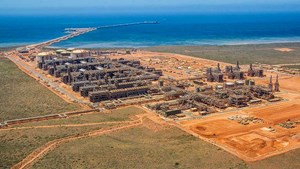Chevron’s flagship carbon capture and storage project “stuck” at one-third capacity
(Bloomberg) – Chevron Corp.’s flagship carbon capture and storage project in Australia faces years of work to hit full capacity, underscoring the challenge of a technology seen as necessary to help the world hit climate goals.
The Gorgon CCS project, one of the largest of its kind in the world, needs investment to boost performance and will be stuck at around one-third of its intended capacity until that’s completed, according to David Fallon, Chevron Australia’s General Manager energy transition.
“We will not hide from the fact that it’s not perfect,” Fallon said Wednesday in an interview on the sidelines of an Adelaide conference. “But it’s still safely storing a significant amount of CO2 every year.”
Gorgon is designed to capture 4 million tons of CO2 a year from a Chevron-led liquefied natural gas plant on Barrow Island and store it in a subsea reservoir. Since its commissioning in 2019, the project has been plagued with difficulties and is currently operating at a storage rate of about 1.6 million tons of CO2 a year.
Oil and gas producers are stepping up global plans to deploy carbon capture projects, both to curb their own climate impact and to develop businesses that will handle emissions generated by third parties. The total number of proposed or operating projects jumped 44% in 2022 to about 196, according to the Global CCS Institute, an industry group.
Critics of carbon capture have cited Gorgon as evidence that the technology is too expensive and technically challenging to be relied on as a climate change mitigation tool. However, organizations including the International Energy Agency insist development of the sector is necessary to decarbonize heavy industry and ensure climate targets are achieved.
Unlike many carbon capture projects which use depleted oil or gas wells to store CO2, Gorgon utilizes a saline aquifer that never contained fossil fuels and has encountered problems with water pressure. Solutions being reviewed by project teams include proposals to remove water and transfer it into another reservoir nearby, allowing CO2 to be injected at a higher rate.
An investment decision on that project is expected this year and completing the work would likely take years, rather than months, Fallon said. “That will allow us to move the CO2 injection rates back up,” he said.
Under an agreement with the Western Australian government, Chevron must buy around 2.3 million tons-worth of carbon offsets every year to make up the shortfall in its capture capacity.



